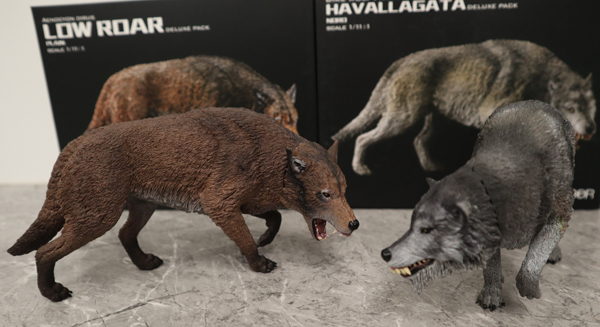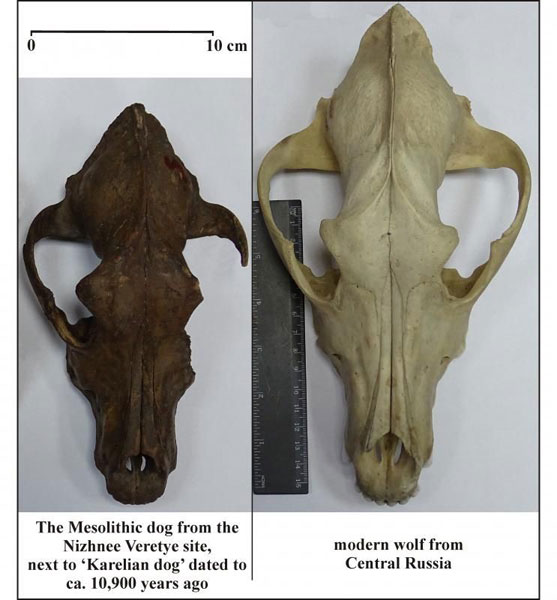New DNA Study Highlights Ancient Relationship Between Us and Dogs
Dogs Really are Our Oldest Friends
An international team of scientists including researchers from The Francis Crick Institute (London), University College Dublin, Ludwig Maximillian University (Munich), Stockholm University (Sweden) and Liverpool John Moores University, have collaborated together in order to sequence a total of 27 ancient dog genomes in a bid to unravel the evolution of the domestic dog. Dogs are widely believed to be the first animal to be domesticated, but very little is known about their population history and to what extent population changes are linked to humans.
Writing in the academic journal “Science”, the researchers present evidence that there were different types of dogs more than 11,000 years ago in the period immediately following the last Ice Age.
One of the Ancient Dog Skulls Compared to the Skull of a Modern Wolf
Picture credit: E. E. Antipina (Institute of Archaeology of the Russian Academy of Sciences)
By sequencing the ancient DNA from the 27 specimens, some of which lived around 11,000 years ago, the team found that by the end of the last Ice Age before any other animal had been domesticated, there were already at least five different types of dog with distinct genetic ancestries.
This study suggests that the diversity observed between dogs in different parts of the world today originated when all humans were hunters and gatherers.
Commenting on the significance of this research Pontus Skoglund (The Francis Crick Institute) stated:
“Some of the variation you see between dogs walking down the street today originated in the Ice Age. By the end of this period, dogs were already widespread across the northern hemisphere.”
Extracting Genetic Information from Skeletons
By extracting genetic information from the skeletons of ancient dogs the team were able to analyse the DNA they found providing a window into the past. They were able to show that over the last ten millennia these early dog lineages mixed and moved giving rise to the dogs we know today. For example, the researchers calculated that early European dogs were initially diverse, most likely originating from two highly distinct populations, one related to Near Eastern dogs and another cluster related to dogs from Siberia. However, at some point this diversity was lost, as it is not found in European dogs today.
Lead author Anders Bergström, a post-doctoral researcher at The Francis Crick Institute commented:
“If we look back more than four or five thousand years ago, we can see that Europe was a very diverse place when it came to dogs. Although the European dogs we see today come in such an extraordinary array of shapes and forms, genetically they derive from only a very narrow subset of the diversity that used to exist.”
DNA Studies Unravels Dog Evolution and the Evolution of Wolves

Picture credit: Everything Dinosaur
The picture (above) shows two models of dire wolves (Aenocyon dirus). These are Rebor figures. Genetic analysis of dire wolf fossils has revealed that these animals are not closely related to North American wolves.
To view the Rebor range of models and figures: Rebor Figures and Models.
Comparing Human Evolution to Dog Evolution
The researchers also compared the evolution in dog population to changes in human evolution, lifestyles and migrations. In many cases comparable changes took place, likely reflecting how humans would bring their dogs with them as they migrated across the world. However, this study also identified that dog evolution and human history do not mirror each other. The loss of European dog diversity is not reflected in human population studies.
Co-author Ron Pinhasi (University of Vienna), added:
“Just as ancient DNA has revolutionised the study of our own ancestors, it’s now starting to do the same for dogs and other domesticated animals. Studying our animal companions adds another layer to our understanding of human history.”
This newly published research might provide a fresh perspective on the early history of dog populations and their relationship with our own species, but still, many questions remain. Dogs may have been the first animal to become domesticated, likely originating from wolves that associated with humans, however, when and how the first wolves became dogs is still not known.
The scientific paper: “Origins and genetic legacy of prehistoric dogs” by Anders Bergström, Laurent Frantz, Ryan Schmidt, Erik Ersmark, Ophelie Lebrasseur, Linus Girdland-Flink et al published in the journal Science.
Visit the Everything Dinosaur website: The Everything Dinosaur Website.


